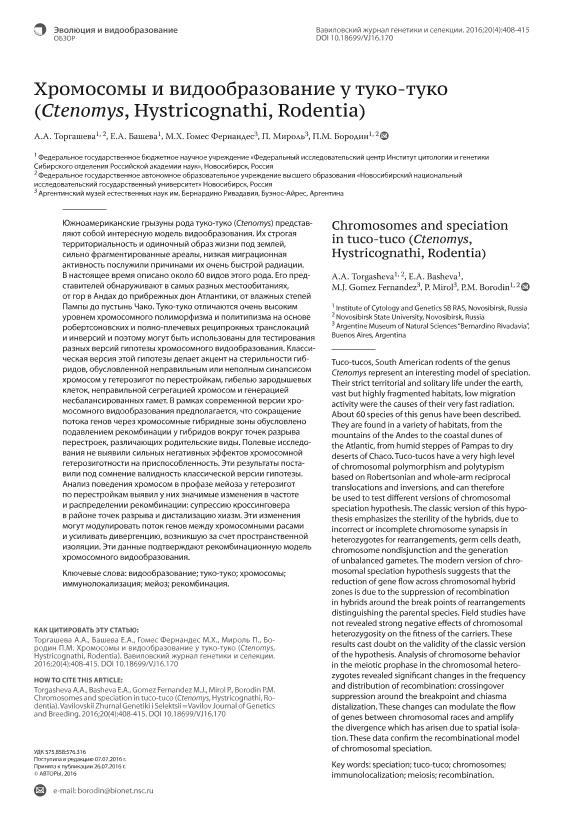Mostrar el registro sencillo del ítem
dc.contributor.author
Torgasheva, Anna A.
dc.contributor.author
Savchenko, Ekaterina

dc.contributor.author
Gomez Fernandez, Maria Jimena

dc.contributor.author
Mirol, Patricia Monica

dc.contributor.author
Borodin, Pavel M.
dc.date.available
2018-06-19T18:01:17Z
dc.date.issued
2016-09
dc.identifier.citation
Torgasheva, Anna A.; Savchenko, Ekaterina; Gomez Fernandez, Maria Jimena; Mirol, Patricia Monica; Borodin, Pavel M.; Chromosomes and speciation in tuco-tuco (Ctenomys, Hystricognathi, Rodentia); Institute of Cytology and Genetics of Siberian Branch of the Russian Academy of Sciences; Vavilov Journal of Genetics and Breeding; 20; 4; 9-2016; 408-415
dc.identifier.issn
2500-0462
dc.identifier.uri
http://hdl.handle.net/11336/49341
dc.description.abstract
Tuco-tucos, South American rodents of the genus Ctenomys represent an interesting model of speciation. Their strict territorial and solitary life under the earth, vast but highly fragmented habitats, low migration activity were the causes of their very fast radiation. About 60 species of this genus have been described. They are found in a variety of habitats, from the mountains of the Andes to the coastal dunes of the Atlantic, from humid steppes of Pampas to dry deserts of Chaco. Tuco-tucos have a very high level of chromosomal polymorphism and polytypism based on Robertsonian and whole-arm reciprocal translocations and inversions, and can therefore be used to test different versions of chromosomal speciation hypothesis. The classic version of this hypothesis emphasizes the sterility of the hybrids, due to incorrect or incomplete chromosome synapsis in heterozygotes for rearrangements, germ cells death, chromosome nondisjunction and the generation of unbalanced gametes. The modern version of chromosomal speciation hypothesis suggests that the reduction of gene flow across chromosomal hybrid zones is due to the suppression of recombination in hybrids around the break points of rearrangements distinguishing the parental species. Field studies have not revealed strong negative effects of chromosomal heterozygosity on the fitness of the carriers. These results cast doubt on the validity of the classic version of the hypothesis. Analysis of chromosome behavior in the meiotic prophase in the chromosomal heterozygotes revealed significant changes in the frequency and distribution of recombination: crossingover suppression around the breakpoint and chiasma distalization. These changes can modulate the flow of genes between chromosomal races and amplify the divergence which has arisen due to spatial isolation. These data confirm the recombinational model of chromosomal speciation.
dc.format
application/pdf
dc.language.iso
rus
dc.publisher
Institute of Cytology and Genetics of Siberian Branch of the Russian Academy of Sciences
dc.rights
info:eu-repo/semantics/openAccess
dc.rights.uri
https://creativecommons.org/licenses/by/2.5/ar/
dc.subject
Speciation
dc.subject
Tuco-Tuco
dc.subject
Chromosomes
dc.subject
Immunolocalization
dc.subject
Meiosis
dc.subject
Recombination
dc.subject.classification
Otras Ciencias Biológicas

dc.subject.classification
Ciencias Biológicas

dc.subject.classification
CIENCIAS NATURALES Y EXACTAS

dc.title
Chromosomes and speciation in tuco-tuco (Ctenomys, Hystricognathi, Rodentia)
dc.title
Хромосомы и видообразование у туко-туко (Ctenomys, Hystricognathi, Rodentia)
dc.type
info:eu-repo/semantics/article
dc.type
info:ar-repo/semantics/artículo
dc.type
info:eu-repo/semantics/publishedVersion
dc.date.updated
2018-05-30T15:14:49Z
dc.identifier.eissn
2500-3259
dc.journal.volume
20
dc.journal.number
4
dc.journal.pagination
408-415
dc.journal.pais
Rusia

dc.description.fil
Fil: Torgasheva, Anna A.. Novosibirsk State University; Rusia. Institute of Cytology and Genetics; Rusia
dc.description.fil
Fil: Savchenko, Ekaterina. Institute of Cytology and Genetics; Rusia
dc.description.fil
Fil: Gomez Fernandez, Maria Jimena. Consejo Nacional de Investigaciones Científicas y Técnicas. Oficina de Coordinación Administrativa Parque Centenario. Museo Argentino de Ciencias Naturales "Bernardino Rivadavia"; Argentina
dc.description.fil
Fil: Mirol, Patricia Monica. Consejo Nacional de Investigaciones Científicas y Técnicas. Oficina de Coordinación Administrativa Parque Centenario. Museo Argentino de Ciencias Naturales "Bernardino Rivadavia"; Argentina
dc.description.fil
Fil: Borodin, Pavel M.. Novosibirsk State University; Rusia. Institute of Cytology and Genetics; Rusia
dc.journal.title
Vavilov Journal of Genetics and Breeding
dc.relation.alternativeid
info:eu-repo/semantics/altIdentifier/url/http://vavilov.elpub.ru/jour/article/view/693
dc.relation.alternativeid
info:eu-repo/semantics/altIdentifier/doi/http://dx.doi.org/10.18699/VJ16.170
Archivos asociados
